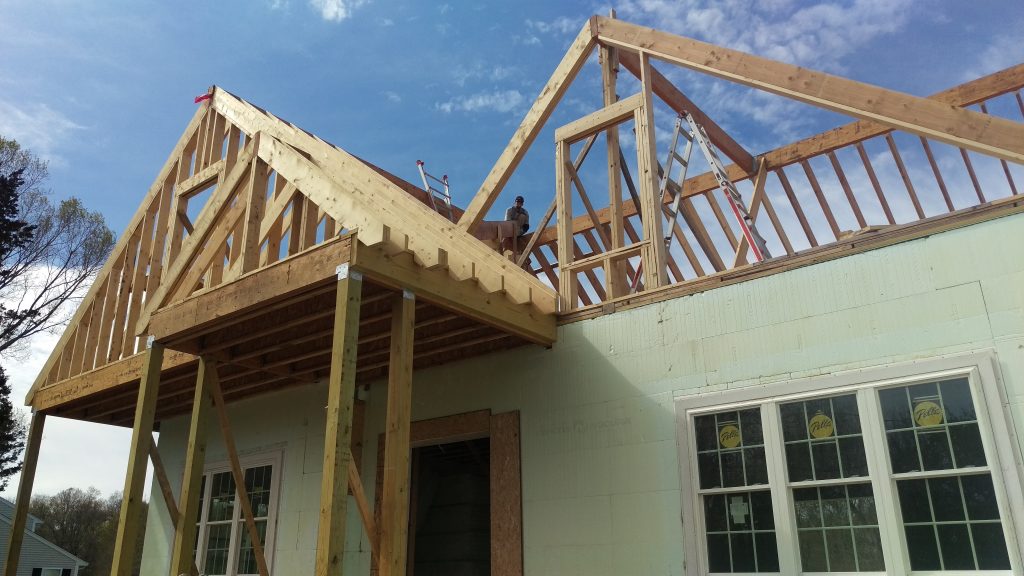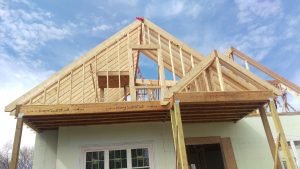
Keith Pedro, of Keith & David Home Improvements (Falmouth, MA), is rocking out the roof framing of a local green home† he is building. (Credit: Keith Carreiro, May 2016.)
Fiction is the truth inside the lie.
I have been thinking how writing a novel, especially one that is the basis for a series, is quite similar in complexity to building a home.
In driving to work to teach my classes over the last year, I have been watching the transformation of a nearby homestead. An old, abandoned farm house was knocked down. It was completely disassembled from the ground up, even to the point where the old foundation and basement were taken out.
A whole new site over the old one was then created.
Gradually, over a period of seven months, the form of a new building took shape.
Without doubt, building a house, and building it well, is a complex, multifaceted process. It is not just the building of the house that factors into this task alone. It costs a lot of money for home construction. What kind of financing is required to build one?
Is insurance coverage (if not provided by the builder) for the course of construction, general liability & workman’s compensation required?
Should an attorney be consulted?
Once these areas of concern are addressed, the best property for one’s budget needs to be purchased.
Building a home includes answering such questions, minimally, as where to build it, on what type of location will the house be positioned, where on site will it be positioned and who will survey the property? Also, what style of house is desired? How many cubic feet will it have? Who will draw up the plans?
Who will oversee the whole project? Will one firm do it all, or will a building manager parcel out the various tasks of, for example—
Construction permits (septic, electrical, plumbing, mechanical)
Site clearance and design,
Perk testing (if there is no city or town sewerage hookup available)
Drilling for water (if there is no city or town water available),
Excavating the basement area,
Laying the foundation,
Framing,
Roofing,
Electrical,
Plumbing,
HVAC,
Flooring installation,
Trim & finish work
There is nothing to writing. All you do is sit down at a typewriter and bleed.
— Ernest Hemingway (1899–1961)
I spent a bit of time talking with Keith Pedro after he kindly climbed down from the roof to meet with me. He was rocking it into place. In speaking with him, I could not but help notice that there is a definite gleam of pride in Keith’s eyes about what he is building here. He has a can–do spirit that simply emanates from him and animates everything he explains to me about what he is doing, especially in terms of building a green home (Please refer to the related links section at the end of this column.).
He has been working on this project through four seasons, rain or shine, cold or hot, alone and sometimes with help. As he detailed out the various phases of the construction he has done, I could not help but see that there is a definitive choreography happening here, and he has been at the center of it.
I liked the confidence he shows in his abilities, in the materials he has used, and in the building products he soon will be using, some of which are stacked around the exterior perimeter of the house. This is the fourth green home he has built. He talked with me about the advantages of building such a home, as well as the remaining steps he needed to do to complete the job. He talked about the insulation benefits of this style of construction and the importance in having an excellent ventilation system as well.
All in all, it was a fascinating lesson I learned from him about what he was creating.
After my conversation with Keith, and on my drive home, I was more than convinced of the parallels common to framing a house and building a story.
Tackling a novel, like constructing a home, takes on a similar component consideration with a substantial breakdown of the tasks required in doing so. Here is an overview of most of them below:
When to write
Rocking a Frame. (Credit: Keith Carreiro, May 2016.)
Where to write
Story idea
Where to start in the story [Kurt Vonnegut (1922–2007) advises to write as near to the end as possible.]
Type of novel
Story length
Knowledge base in writing
Resources needed for writing
Resources need for researching the story itself
Plot [the what]
Setting [the where & when]
Characterization [the who]
Thematic concern (message, idea, lesson of the story) [the why]
Style [the how]
Tone
Writer’s voice
Use of diction
Conflict
Resolution
Scenes
Anyone who imagines that all fruits ripen at the same time as the strawberries knows nothing about grapes.
— Paracelsus (1493–1541)
Reviewing the two lists above, the first one on home building, the second on novel writing, I can see how many people might say something like, “Why bother getting involved in either one? It’s all way too complicated; and, it sounds like too much work.”
Certainly, given the amount of specialization and knowledge (theoretical and practical) each endeavor requires, including the respective tasks required within each one, both kinds of endeavors demand that a daunting and exhaustive effort needs to be given them. Each endeavor must not be entered into and taken lightly.
There is an old adage that reveals the challenges found in successfully writing and finishing a novel: Of every hundred people who begin one, three will see its completion. Of those writers who do see the end result of their efforts, it often takes them years to complete a 70,000 to 140,000 word story.
There are many failed housing starts and there are many failed novels as well.
What makes for a successful home to be crafted, and what makes the building of a story just as successful, too? What makes the difference in these two activities being a burden or a blessing?
Oddly enough, I have seen that master carpenters and those who love the building trades, have a common spirit with those who have a love of the literary arts. They have a passion for what they do and cannot see themselves doing anything else. In crafting a beautiful home and hammering out a story (No, I am not using mixed metaphors here.), both share a zeal to see a vision realized. In doing so, they receive an affirmation of who they are as artists.
I dream my painting and I paint my dream.
? Vincent van Gogh (1853–1890)
I think framing a building is similar to a painter stretching out a canvas and framing it as well. As I wrote in my tribute to Lennie Breau, he sought to play music as a painter uses color. What one doesn’t play, paint or build is as important as what one doesn’t say in his or her writing. I look at what is being made in all of these various created forms as living narratives to those who have given rise to their unique expressions.
They have given voice, artistic utterance, to the vision within themselves . . .
Don’t play what’s there; play what’s not there.
— Miles Davis (1926–1991)
Related Links:
†Information on Green Building:
http://www.greenbuildingadvisor.com/content/what-green-building:
Green building is an approach to construction that can be applied to public and commercial buildings as well as the houses we live in. It guides every step of design and construction, from choosing a building site to installing a heating system. Green building is alternately described as “sustainable” building, and ultimately this may be a more accurate way of looking at it.
Green buildings are as varied as the people who live in them. There is no single template for a green house. But even though green houses may look different from the outside, their designs are based on three broad principles:
Energy efficiency. The house uses as little energy as possible. Whenever feasible, renewable forms of energy should replace fossil fuels, which by definition are not renewable.
Conservation of natural resources. This broad objective recognizes that resources are finite. There is only so much timber, ore and water to go around, and what resources are available to us should be used thoughtfully. Seen through this lens, durability, low environmental impact and low maintenance all become important attributes for a house.
Excellent indoor air quality. Green homes are designed to be healthy houses. A green home shouldn’t have moisture, mold, or radon problems. Building materials, furnishings, paints and finishes should not contribute toxins and irritants to indoor air. Even with clean air though, houses need mechanical ventilation that assures a steady flow of fresh air.
See also:
https://archive.epa.gov/greenbuilding/web/html/
http://www.calrecycle.ca.gov/GreenBuilding/Basics.htm
If you enjoyed reading this post, please share it with others.
Disclosure of Material Connection: I have not received any compensation for writing this post. I have no material connection to the brands, products or services that I have mentioned here. I am disclosing this information in accordance with the Federal Trade Commission’s 16 CFR, Part 255: “Guides Concerning the Use of Endorsements and Testimonials in Advertising.”



1 comment. Leave new
Excellent Blog!!